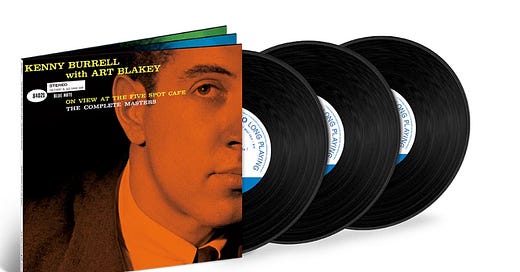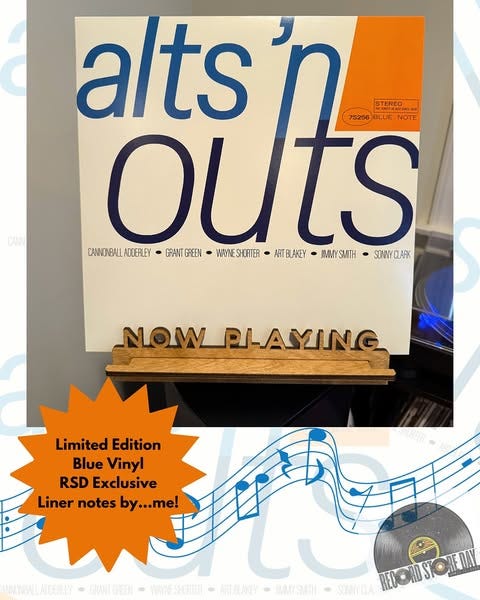Streaming, Scheming, and Screaming into the Void
Anti-AI Jazz, Notable Happenings, and the Vinyl Countdown to Record Store Day
What’s Playing, What’s Staying
2025 started as a trickle—just a few reissues, and a couple of new releases. But that trickle turned into a stream, then a river. With Record Store Day approaching and a wave of major drops on the horizon, I’ve been sorting recent acquisitions into three stacks: the turntable-adjacent “heavy rotation” pile, the stack headed for library shelving, and a stack that will find a better home. A great music library is measured in quality, not quantity, so grooming, pruning, and curation of one’s collection is essential. Otherwise, you run out of room and leave a chunk of your library that you’ll rarely or never play. This increases the likelihood of misplacing something that you DO want to hear. Or, the chaos simply gets out of control. A bit like my hair from my Grateful Dead touring days.

The jazz record from 2025 (so far) that keeps finding its way to the top of the heavy-rotation stack is Arboresque, the latest from Artemis.
Eight years and three albums in, the women of Artemis seem understandably exhausted by the persistent use of “all-female jazz supergroup” in press copy. Fair point. I’ve spun Arboresque more than any other jazz album this year, and I don’t hear a gendered qualifier—I hear a band. A great band. Yes, jazz is still a boys’ club. So yes, let’s acknowledge that Artemis is outplaying most of the field and changing the rules while they’re at it.
Trimmed to a lean, elastic quintet—Renee Rosnes (piano/Rhodes), Ingrid Jensen (trumpet), Nicole Glover (tenor), Noriko Ueda (bass), Allison Miller (drums)—the group leans into mindfulness, creating space and tension with intention. Jensen calls it “anti-AI,” and that’s spot-on. The music of Artemis is deeply emotional, human, and brimming with nuance no machine could generate, even with the power of a thousand suns. Somewhere, a ChatGPT-generated jazz solo just wept synthetic tears into a neural napkin.
Each Artemis member contributes a composition, with Rosnes linking the originals to thoughtful arrangements of Wayne Shorter’s “Footprints,” Burt Bacharach’s “What the World Needs Now Is Love,” and Donald Brown’s “The Smile of the Snake.” Glover’s “Petrichor” is a beautiful ballad. Ueda’s “Komorebi” deserves to become a modern standard. And the elegant groove of Miller’s “Little Cranberry” is almost perfect—my only complaint is that it ends too soon.
The sound quality is top-notch. If you’ve got Atmos capabilities, the spatial mix is immersive and intimate. The vinyl pressing is excellent—detailed, open, and beautifully mastered. This one’s staying in the “heavy rotation” stack for a while.
I’ve said more than enough. Let the music do the talking. Here’s the band from Jazz in Marciac on July 31, 2024, taking “Footprints” for a joyride:
Stacks, Snacks, and What’s For Dessert?
New albums and reissues are arriving fast ‘n furious, with liner notes, interviews, album reviews, an inbox full of embargoed press releases, and my coffee budget in serious jeopardy. Here’s what’s either just landed or coming soon:
First up, three projects which include my liner notes that recently made their public debuts: the Tone Poet editions of Dizzy Reece’s Blues in Trinity, Art Pepper’s Modern Art, and the Super Deluxe Edition of Yes’s Close to the Edge. These couldn’t be more different sonically, but all were a joy to work on. I jumped at the chance to write about unsung trumpet hero Dizzy Reece—especially for the record pairing him with Tubby Hayes, one of my favorite British jazz artists, ever. The Pepper set is pure West Coast cool with an edge, while Close to the Edge is peak prog ambition wrapped in Roger Dean wizardry and bundled with an array of previously unreleased material. Different vibes, same obsessive attention to narrative detail.
Looking ahead, I’ve got several big releases putting their seats and tray tables in the upright and locked positions as they prepare for landing. Alts N’ Outs is a Record Store Day 2025 exclusive, collecting six tracks on vinyl for the first time from six legendary Blue Note sessions. If you’ve been following along on Instagram, you’ve seen the track-by-track teaser carousel. It’s a deep crate dive that I was honored to write the notes for—alternate takes that feel like alternate timelines. Grant Green’s extended “Jean de Fleur” and Wayne Shorter’s tastes-great-less-filling auxiliary take on “Dance Cadaverous” make the familiar seem brand new, and those are just two highlights among six.
There’s also Charles Rouse’s Two Is One, part of the long-awaited relaunch of Strata-East, which should send spiritual jazz heads into a mild frenzy while still leaving them enough pocket money for a slice of pizza. And then there’s Kenny Burrell & Art Blakey’s On View at the Five Spot: The Complete Masters—one of my most ambitious liner note projects to date. The original LP had charm, but this expanded version has the kind of rizz that can elevate it to a must-own. Previously unreleased live hard-bop magic featuring Tina Brooks from 1959? Yes, please!
Outside the liner note rabbit hole, I’m gearing up for an upcoming interview with Hiromi, whose new album Out There drops April 4. I haven’t spoken with her yet, but I’ve been living with the record, and… it’s remarkable. Equal parts cinematic, ferocious, and deeply melodic—it’s the kind of album that invites both repeat listens and ridiculous metaphors. (The last time I heard synth work this textural, I had to check for hidden Tangerine Dream credits.) I’m especially excited to catch her and her band Sonicwonder live at the Blue Note next week. Interview coming soon, right here on the Substack. In the meantime, I’m completely obsessed with Hiromi’s ambitious, long-form, occasionally-bordering-on-prog-rock title track. Here’s the third part of that epic, “Out There: Orion:”
Also worth noting: I had the pleasure of serving as MC last night for a listening event at All Blues hosted by none other than Zev Feldman, aka The Jazz Detective. Zev previewed his upcoming Record Store Day releases, which include four heavy hitters: Bill Evans – Further Ahead: Live in Finland (1964–1969), Patsy Cline – Imagine That: The Lost Recordings (1954–1963), Freddie Hubbard – On Fire at the Blue Morocco 1967, and Kenny Dorham – Blue Bossa in the Bronx: Live from the Blue Morocco. The room was full, the playback was lively, and Zev—as always—delivered history with heart. The whole thing was filmed and will be posted in the coming days over at Analog Planet. I’ll share the link once it goes live.
Earlier this week, I had the pleasure of guesting on the Unlimited Supply podcast, hosted by longtime friend and digital music sage Lars Murray. If you work in or around the music industry, you probably already know the show—it’s a tight, info-packed eight-minute daily on news, tech, and weirdness from the business side of music. Lars let me loose on a few pet topics, including archival releases, Record Store Day expectations, and the ever-tense dance between fans and labels. You can listen below via Apple Music podcasts, and the episode is also available on your podcast platform of choice.
While we’re on the subject, I’m putting the finishing touches on a Record Store Day 2025 buying guide that will drop next week. I’ve been in deep listening communion—headphones, notepads, dirty coffee mugs—and the result is a stacked overview that should help you figure out exactly how early you’ll need to wake up. Spoiler alert: earlier than you want to.
The Vinyl Straw: Real Revenue, Fake Streams
The International Federation of the Phonographic Industry (IFPI) has released its annual music industry report for 2024, containing notable trends of interest to musicians, industry professionals, and music enthusiasts. The 50-page PDF is worth reading if you have the time, but as most folks won’t, I’ve collected the essential points (in bold) with my asides in italics:
The global music industry recorded its 10th consecutive year of revenue growth, reaching $29.6 billion in 2024. While that’s a 4.8% increase, it’s a HUGE slowdown from prior years (2021: 18.5%, 2023: 10.2%), and the slowest rate since 2015.
The music business now feels like your friends hitting their 30s—technically, still growing, but the peak party years are clearly behind them.
Streaming remains the industry’s bread & butter, accounting for 69% of total revenue, driven by subscriptions (up 9.5%, down from 11.2% in 2023). Physical format revenue dipped 3.1% overall—but vinyl saw its 18th straight year of growth, up 4.6%.
Can we stop calling it a “vinyl revival” now? It’s been nearly two decades. This is less “comeback” and more Walking Dead. Still spinning, still spawning new variants, and somehow still dragging people out of bed in the pre-dawn hours on Record Store Day.
Regional performance is literally all over the map: the Middle East, Africa, and Latin America surged with over 22% growth, while the U.S. crawled to just 2.2%. Also, Mexico broke into the top 10 global music markets, knocking Australia out.
The U.S. music market is the New York Yankees of 2024—historically dominant, reputationally impressive, currently mid. Meanwhile, the global music market is starting to resemble Eurovision, with unexpected acts from once-overlooked places stealing the show.
Independent artists are facing unprecedented pressure—oversaturation (1 million new tracks weekly), microscopic streaming royalties, rising tour costs, burnout, and the algorithmic hamster wheel.
Being an indie musician in 2024 is like being a TikTok influencer who occasionally sings and solos. It’s constant content, endless analytics, and a prayer circle for the algorithm gods to notice you. Labels may have lost their monopoly, but DIY still means doing everything yourself—with no IT support when your track mysteriously disappears from Spotify. Demystifying analytics feels like a cruel punishment for skipping algebra—didn’t many musicians BECOME musicians in the first place so they WOULDN’T have to wrestle with complex math problems?
Streaming manipulation fraud has become a significant threat, intensified by generative AI’s ability to produce convincing fake streams.
Music streaming has entered its misinformation era. Think less Napster and more troll farm. AI-generated filler now competes with real musicians for chart space. I haven’t seen this much fakery since my boss insisted on a team-building dinner at Hooters.
Gaming is emerging as a major platform for music, creating powerful new opportunities for artist-fan engagement.
Gaming is now the Coachella of Gen Alpha—a place where aging musicians go to convince 13-year-olds they’re still relevant. Great for the right acts. But c’mon, no one’s firing up Fortnite to hang with the Steve Miller Band.
AI is both a financial threat and a creative opportunity, depending on who’s talking. It risks eroding artist revenue and diluting IP interests while enriching the tech sector. Rights frameworks aren’t evolving fast enough. Labels are calling for regulation—while quietly investing in the tech itself.
Record labels preaching AI ethics is like McDonald’s selling salads. Also: they’re hedging their bets with “schmuck insurance”—funding startups just in case they win big. It’s Big Music’s favorite side hustle.
Paradoxically, labels also see AI as a creative tool—restoring old voices, finishing lost songs, or even building out new ones.
The same folks issuing dire warnings about AI are also inviting it to dinner. It’s like Netflix warning about screen addiction while hyping the next season of Stranger Things. Still, if an AI company screws you over, you’ll want a major label in your corner. They’re helicopter parents—occasionally overbearing, but indispensable when it hits the fan.
Until next time…







